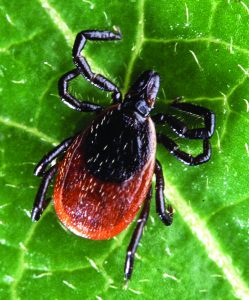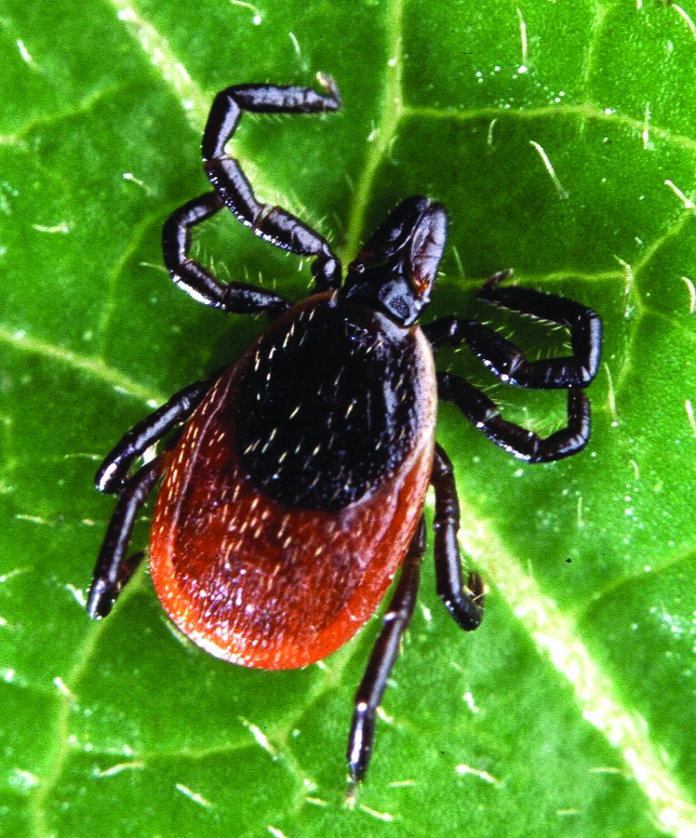Mild temperatures and moisture make for high risk in 2019
By Hayden Seder

The snow is melting, which means getting outside is on people’s minds. But the heavy winter snowfall and recent rains make for a moist environment, and that means more ticks than usual. People, pets and livestock are all at higher risk for tick bites and infections, which means knowing where ticks are most prevalent, how to spot ticks and tick-bite symptoms, and what diseases are caused by ticks are important.
Where to Find Ticks
Everywhere! Tick exposure is a risk year-round but they are most active between April and September. Dr. Frank Batcha, a family medicine practitioner for St. Luke’s, warns that ticks can be anywhere in the outdoors, whether it’s the woods or your own backyard.
“Since ticks are dependent on mammalian hosts, they have a tendency to have denser populations where there would be a lot of mammalian traffic, like game trails and hiking trails,” Dr. Batcha said. “The bottom line is, anywhere you can be outside, it’s possible to be exposed to them.”
When outside, try to keep yourself and your animal out of high grass or to walk in the center of trails.
Ticks are also sensitive to changes in humidity, which is why tick bites are more rare at the height of summer when high heat and low humidity kill many of them.
“Tick exposures are much more prevalent in spring and fall when it’s damp and humid with cooler temperatures,” Dr. Batcha said. “That’s when people need to be more aware.”
Diseases and Symptoms Related to Tick Bites
According to the Centers for Disease Control (CDC), the most prevalent tick for the local area is the Rocky Mountain wood tick, which transmits Rocky Mountain spotted fever, Colorado tick fever and tularemia.
Rocky Mountain spotted fever is one of the deadliest tick-borne diseases in America, causing fever, headache and rash, and can be deadly if not treated right away. But, unlike the name implies, the disease is most prevalent in the Southeast and is somewhat rare in the Rocky Mountains.
According to Dr. Batcha, the disease seen most in the Wood River Valley is Colorado tick fever, which has similar symptoms to all other tick-borne illnesses, including malaise, body aches, headaches and rash.
“Tick-borne illnesses are all fairly difficult to distinguish, clinically,” Dr. Batcha said. “How we distinguish the non-specific symptoms of tick-borne illness from a virus is that a virus attacks the respiratory system, which means there wouldn’t be any sneezing or coughing if it is a tick-borne illness.”
Lyme disease is often what people think of first when thinking of tick-borne illness, but it’s incredibly rare to see Lyme disease in Idaho, as the Lyme bacteria does not occur naturally in Idaho and is typically seen more on the East Coast or Northwest coast. “All of our cases of Lyme disease here in Idaho have been imported from other places where Lyme bacteria is present,” said Dr. Batcha.
Most victims of a tick bite won’t know they’ve been bitten, as the bites are painless. But if you or your animal have been outside during the spring or fall, do a full body check, making sure to look on the legs as well as collars and waistbands of clothing.
Preventing Tick Bites
“The best treatment for tick-borne diseases is prevention,” Dr. Batcha said.
There are a number of ways to prevent tick bites on both yourself and your animals. One is to layer clothing and make barriers where ticks can’t get in, such as by wearing drawstrings at the bottom of pants or tucking your shirt into your pants. The insect repellent DEET is a good tick deterrent for both people and animals to wear on themselves, while products containing permethrin can be used to treat boots, clothing and camping gear for both ticks and mosquitoes.
For Dogs
Ticks aren’t just a nuisance for humans—they can affect dogs, as well. Preventative measures for dogs include topical creams, chewable pills, and collars, all of which work to prevent tick bites for certain periods of time.
A topical cream is typically applied to the middle of the dog’s back and will be good for a month while the chewables are generally good for three months.
“You have to be diligent and give your dog the preventative measure religiously or ticks will come back,” veterinarian Dr. Rhonda Aliah advises.
Aliah advises checking your dog for ticks any time you come back from a walk or hike, particularly at the base of the ears, between their toes, along the belly and in the arm pits where the dog is more likely to come in contact with the shrubs and tall grasses that ticks live on.
If you find a tick on your dog, it is recommended to remove it the same way you would on a person, a using a credit card or a fingernail and scraping against the skin to ensure you remove the head with the tick’s body. Some tick diseases can make an animal sick, so if you notice that your dog is breathing heavily, is very weak, lethargic or not eating well, bring it in to your local vet’s office.



